Now phone networks are faster and more mobile devices know where they are, permitting a second generation of location-based multiplayer games. Undoubtedly the leading second-generation mobile phone game is Mogi: Mogi uses both the position of players in the landscape, and the landscape itself to generate play.
Play the Data Layer
Mogi is a collecting game - "item hunt". The game provides a data-layer over the city of Tokyo.
 As you move through the city, if you check a map on your mobile phone screen, you'll see nearby items you can pick up and nearby players you can meet or trade with.
As you move through the city, if you check a map on your mobile phone screen, you'll see nearby items you can pick up and nearby players you can meet or trade with.Mogi was developed by Newt Games, based in Paris France. I talked to CEO Mathieu Castelli at his home there. He discussed the true integration of items in the environment: "some items only appear at certain places, at certain times." For example, Castelli cites the creatures in the game: "We used the map to give creatures some interesting behavior. Some creatures only hunt at night. Some hang around close to parks." If a player wants to find that creature, they'll have to travel near a park in the evening hours.
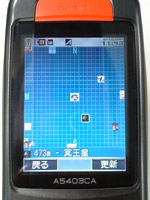
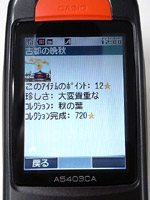
Two images from the mobile Mogi client - a radar showing nearby objects, and a detailed view of an item. Click for a blow-up. Photos: Paul Baron.
As exciting as this environmental gaming sounds, Castelli gets most excited talking about the links between the web and the mobile device. Mogi has a client for mobile phones, and a client for the desktop internet. Desktop internet players have access to a larger map. Newt Games's idea is to have the desktop players guiding the mobile internet players, a goal of collaborative play, team work.
Castelli talks about this desktop-mobile connection in the context of typical massively-multiplayer online game: "Casual players don't seem so useful for a guild in a regular MMOG. In [Mogi] the casual player is somewhere, the casual gamer has his location going for him. For a team, the location of the player is something useful. The desktop player can send a tool to the mobile players, and teach them how to use it." Think of this way: the web interface becomes a means for the hardcore players to orchestrate the experience for the mobile (casual) players. This is a beautiful, mind-boggling scenario: have the gaming veterans teaching and leading the casual gamers. Interdependence - with the right interface, many skill levels might play together.
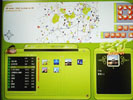
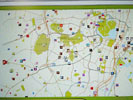
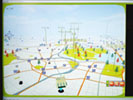
Three images from the desktop web interface to Mogi. Click for a blow-up. Photos: Paul Baron.
Collecting, Not Combat
Mogi is actually just an abbreviated version of the dream game design Castelli and company have been working on. Kigen was Newt Games's first product, which they stopped developing in late 2002 to get a product to market to keep their company afloat. Kigen resembles Mogi, with additional layers of complexity added: combat, technological evolution, conquering neighborhoods. Computer game players might think of Kigen as location-based StarCraft with a Civilization tech tree. Castelli agrees with a laugh that they were probably too early and too ambitious with that game design.
Amy Jo Kim specializes in social design for networked environments. She gave a talk at the recent Game Developer's Conference in San Jose concerning "Social Trends in Mobile Entertainment" and Mogi was an important part of her remarks. We reached her for comment by phone from her office in Half Moon Bay, California: "[Mogi] is a good example of a style of entertainment suited for mobile devices. It's very casual, playable on your way somewhere. It nestles in your every day life, rather than requiring you to change your behavior." Kim continues, "It amplifies your ordinary behavior - it changes going on an errand into a piece of a game."
Most of the early location-based games have emphasized combat over collecting; Kim was glad to see Mogi reversed that: "They chose a game mechanic that emphasizes multiple ways to play." Players can run around the landscape collecting things, or they can remain in one place and trade with other players. This is more accessible than aggressive play, she argues: "Trading is a very social game mechanic, very lightweight, very mainstream." Trading is certainly more female friendly, she continues - important when you consider the great many women who use mobile devices.
mo-mogi
Kim isn't sure the game would make it in the United States: "I could kinda see it working in New York, in a year, in a dense urban place where people don't drive a lot. But the cultural and behavioral context is not present in the US." For now, Mogi runs on Japanese carrier KDDI's phones with built-in GPS capacity. Newt Games is working with France Telecom to use cell-towers for location-based Mogi in Europe. And talks are ongoing with carriers in China and Korea, two places where Castelli sees a natural home for this type of game.
An ex-patriot Frenchman living in Tokyo, Paul Baron has written extensively about Mogi on his weblog in-duce.net. He's a Mogi evangelist - he sent me the game pictures included in this article. He's excited about the game, but wishes he had a flat-rate data plan. From his review of the game, he lists his appreciation for Mogi:
What makes the game so exciting to me?Baron's delight is tantalizing - there are millions of players around the world who would likely love to share these kinds of real-virtual adventures, to have an online game integrated with their errands around a city.
- It uses the GPS in my phone, and that's so cool.
- It maps a virtual data layer onto Japan and brings a fresh new way to look at my map of Tokyo.
- All the trips I make in the city are now randomized, as I will often divert a few hundred meters to go and collect an object around me. I get a chance to discover parts of the city that I ignored, a motivation to check out that parallel street I never took.
- It has a community dimension to it, I chat with other players, I also know how far I am from them and finding out some are less than a few hundred meters to me is really exciting. Over the past month, I bumped into a player who turned out to be the creator of the game, I had to race to pick up a flag that had been put on the map at equal distance between me and another player to encourage us to meet.
Mogi has been in beta test in Tokyo since April 2003, and Newt Games has been steadily adding new features. Each new item, or new game mechanic has resulted in new possible interactions between players. Soon, Castelli envisions, players will be able to treat their captured creatures like Tamogochi, raising and breeding them. And then, soon after, dueling with those creatures in the mobile cityscape, a la Pokèmon.
Giving people the tools to play together in the city: Mogi is a brilliant, obvious envisioning of location-based gaming. Mobile multiplayer the way it was meant to be, providing a data layer players can affect and participate in together, as they inhabit the real world. Today on the streets of Tokyo, Mogi is a shimmering glimpse of what is to come - real and virtual coming in direct physical contact through us the players.
Justin Hall used to live amongst these crawling digital creatures, prowling the parks by evening for special items in Tokyo. Now he works hard to merge real and virtual through Oakland, California and Links.net.